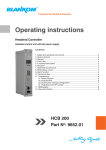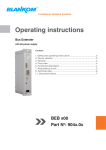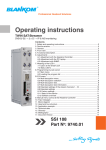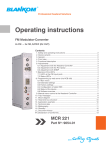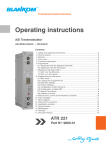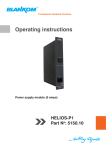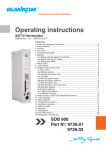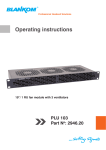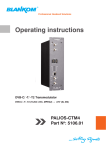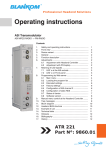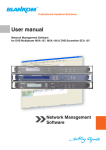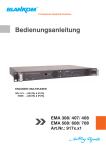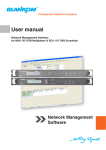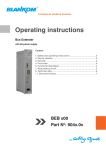Download Operating instructions
Transcript
Professional Headend Solutions Operating instructions Headend Controller Headend control unit with 8A power supply Contents 1. Safety and operating instructions.................................................................... 2 2. Device variants.................................................................................................. 2 3. General ............................................................................................................. 2 4. Front view.......................................................................................................... 3 5. Functional description ...................................................................................... 3 6. Head end bus structure.................................................................................... 3 6.1 Minimum configuration (without Bus Extender) ....................................... 3 6.2 Standard configuration (with Bus Extender) ............................................ 4 7. Head end bus structure.................................................................................... 4 8. Redundancy circuit........................................................................................... 4 9. Alarm function .................................................................................................. 5 10. Technical data ................................................................................................ 5 11. Programming ................................................................................................. 6 10.1 Main program ......................................................................................... 6 10.2 Adjustments ............................................................................................ 6 10.3 Subroutine “Change configuration“........................................................ 7 10.4 Adjusting of the IP number ..................................................................... 7 11. Bibliography ................................................................................................... 8 12. Document history ........................................................................................... 9 HCB x00 Part No: 965x.0x HCB x00 Part N : 965x.0x Headend Controller Headend control unit with 8A power supply o B LINE 1. Safety and operating instructions When assembling, starting-up and adjusting the modules, it is necessary to consider the system specific references in the manual instruction! The modules may only be installed and started up by authorized technical personnel! When assembling the modules into the receiving points, the adherence of the EMC regulations is to be secured! The assembly and wiring have to be done without voltage! All active modules may only be operated with the Headend Controller HCB x00 or Bus Extender BEB x00! The main voltage and the operating voltage of the modules working by DC have to be in complience to the operating parameters described in the technical data. With all work the defaults of the DIN EN 50083 have to be considered! Especially the safetyrelevant execution of the DIN EN 60728-11 [1] is necessary! 2. Device variants HCB 200 HCB 300 HCB 300 9652.01 Headend control unit with 8A power supply (100 ... 240 V~ input) 9653.01 Headend control unit with 8A power supply (48 V– input) 9653.02 Headend control unit with 8A power supply (48 V– input) 3. General The Headend Controller HCB x00 is a module of the head end system B-LINE, which can also be used in the head end system C-LINE/ C-LINE+ . The B-LINE system is conceived as a complete system for middle sized distribution networks, the C-LINE/ C-LINE+ for smaller distribution networks. All active modules are programmed via the central Headend Controller. The individual modules will be addressed by the address switch at the Bus Extender (line) (BEB x00) and at the respective module (position). The status of the modules will be displayed by colored LEDs: · Red - ERROR Control bus error · Green - READY Operating status · Yellow - DATA Data traffic at the internal control bus RJ 45 socket: · Yellow - DATA · Blue - LINK Data traffic (LAN/ WAN) Connection 2 HCB x00 Part N : 965x.0x B Headend Controller Headend control unit with 8A power supply o LINE 4. Front view HCB 200 HCB 300 3 9653.02 INPUT VOLTAGE (DC) 36 ... 72 V INPUT POWER max. 110 W ALARM SOURCE yes ADDRESSING SPACE max. 240 UNITS OUTPUT (DC) 12 V, max. 8 A Display HEADEND CONTROLLER HEADEND CONTROLLER POWER SUPPLY POWER SUPPLY Type: HCB 200 Part No.: 9652.01 INPUT VOLTAGE (AC) INPUT VOLTAGE INPUT FREQUENCY INPUT FREQUENCY INPUT POWER INPUT POWER ALARM ALARM SOURCE SOURCE OUTPUT OUTPUT (DC) (DC) HEADEND CONTROLLER POWER SUPPLY Type: HCB 300 Part No.: 9653.02 Control keys Reset key Type: HCB 200 Part No.: 9652.01 100 ... 240V 100 ... 240 V 50/ 60 Hz 50 / 60 Hz max. 110 W max. 110 W yes yes 12 V,12 V / max. max. 88A A INPUT VOLTAGE (DC) INPUT POWER ALARM SOURCE ADDRESSING SPACE OUTPUT (DC) 36 ... 72 max. 110 max. 240 12 V, V W yes UNITS max. 8A Operating voltage/ control bus (X1, X2) LED “ERROR“ (red) LED “READY“ (green) LED “DATA“ (yellow) LAN/ WAN LED “DATA“ (yellow) LED “LINK“ (blue) + - DC INPUT Power supply 48 V- / max. 3.3 A + - 5. Functional description The Headend Controller HCB x00 is the central control module of the head end or the individual switch cabinet. It consists the data interfaces to a PC/ LAN/ WAN and to the Bus Extender (BEB x00). The head end internal data bus has to be connected as seen in chapter 6 to 8 and the alarm function is descriped in chapter 9. Both bus connections X1 and X2 can be used for that. The data interface to a PC/ LAN/ WAN is implemented as a IP-/ Ethernet interface (RJ 45). Programming can be done but also directly at the control unit (see programming). By pressing the reset-key the HCB x00 reboots and all data of the head end are read out again. The internal power unit supplies the control unit and in case of a Bus Extender (BEB x00) error it will switch automatically to the respective line. The Headend Controller HCB 200 and HCB 300 (9653.02) have an integrated current display, but the HCB 300 (9653.01) hasn‘t this function. It is recommended to use an individual control unit for every circuit (switch cabinet). The IP address of each control unit can be edited and adapted to the respective LAN. Additional information: Redundancy circuit (Headend Controller) Structure (minimum configuration) Option: SNMP and DHCP (chapter 8) (chapter 6) 6. Head end bus structure Module ADDR. 15 Module ADDR. 01 . HCB x00 Module ADDR. 00 6.1 Minimum configuration (without Bus Extender) HCB x00 Headend Contoller The number of the possible module connections (00 ... 15) to a BEB x00 depends on the total power consumption of this line! 3 HCB x00 Part N : 965x.0x o Headend Controller Headend control unit with 8A power supply B LINE Module ADDR. 15 Module ADDR. 15 Module ADDR. 15 Module ADDR. 01 BEB x00 ADDR. 01 Module ADDR. 01 Module signal processing unit Module ADDR. 01 BEB x00 Bus Extender BEB x00 ADDR. 02 HCB x00 Headend Controller BEB x00 ADDR. 15 HCB x00 6.2 Standard configuration (with Bus Extender) The number of the possible module connections (01 ... 15) to a BEB x00 depends on the total power consumption of this line! 7. Redundancy circuit Module ADDR. 15 Module ADDR. 15 Module ADDR. 15 Module ADDR. 01 Module ADDR. 01 BEB x00 ADDR. 01 Module ADDR. 01 broken BEB x00 ADDR. 02 redundancy supply BEB x00 ADDR. 15 HCB x00 (Power supply redundancy) Description of the power supply redundancy With the redundant operation of a system, the control unit HCB x00 will automatically take over the function of the power supply, if the Bus Extender BEB x00 is failing . 4 HCB x00 Part N : 965x.0x o B Headend Controller Headend control unit with 8A power supply LINE 8. Alarm function To activate the alarm function is additional hardware 9651.01 or 9651.02 necessary! The device is endorsed by an additional alarm function and current limitations, voltage drops and communication disturbaces. The contact 13 in the communication and supply bus is switched (+5V to 0 V) in case of alarm. The alarm modules are available in 1 RU and in panel form. It is possible to insert the modules in any order into bus system. The signal is fed to a SUB-D 9 connector via relais in case of alarm. All the contacts are galvanically isolated. It is possible to trigger several kinds of alarm. 9. Technical data Manual operation Input Display 3 operating keys, reset key LCD, lit 19 x 28 mm Remote control Network connection (LAN/ WAN) Input connection Ethernet, 10 Base T RJ 45 Address extent Without Bus Extender With Bus Extender 16 modules 240 modules (15 x 16) Power supply HCB 200 Mains voltage Voltage frequency Mains connector Internal device fuse Power consumption Output DC voltage Rippled noise ratio Current drain Current limit Short circuit protection Overvoltage protection Protective system Protection class Radio noise suppression Temperature range 100 ... 240 V (+10%/ -5%) 47 Hz … 63 Hz built in connector EN 60320-1/ C8 (IEC 320 C8) [3] G 5 x 20, T4A (IEC 127 - 2/ V) max. 110 W 12 V 66 dB max. 8 A** yes (9 A typical) yes yes (≤ 14,5 V)* II acc.. DIN VDE 0860 [4] IP 20 according DIN VDE 0871 (curve B) [5] -10 … +55°C Power supply HCB 300 (9653.01) Input voltage Input current (at 48 V) Power consumption Overcurrent protection Overvoltage protection Max. current drain Voltage stability Radio noise suppression 48 V DC (36 ... 72 V DC) 2.4 A max. 125 W fold back (at 110 ... 143% IOUT) 16.8 ... 20 V 8 A (-10 ... +43 ˚C)** 6 A (+55 ˚C) 1500 V DC (input/ output) EN 55022 (CIS PR22) Class B [6] EN 61000-4-2,3,4,6,8 [7] / ENV 50204 [8] Power supply HCB 300 (9653.02) Input voltage Input connection 48 V DC (36 ... 72 V DC) Plug with screw termina- tion, with polarity protec- tion Fuse Polarity reversal protection Power consumption Voltage stability AC Output DC voltage Rippled noise ratio Output current Current limit Short circuit protection Overvoltage protection Protection class Noise emission Immunity Temperature range T 6.3 A/ 250 V “H“ (5x20, internal“) yes max. 110 W 1500 V (input/ output) 12 V 66 dB 0.25 ... 8 A yes yes, hicc-up mode yes (> 14.5 V) IP 20 EN 55011 [9], EN 55022 (CIS PR22) Class B [6], EN 50083-2 [2] EN 61000-6-1 [10]/ EN 61000-6-2 [11] -10 … +60 °C Environmental conditions Relative humidity Mounting method Mounting location ≤ 80 % (non condensing) vertical splash-proof and drip-proof Physical information Dimensions (l x w x h) without 19“-adapter with 19”-adapter Weight HCB 200, 300 (9653.02) HCB 300 (9653.01) 50 x 276 x 148 mm 50 x 301 x 148 mm about 1,500 g about 1,600 g Delivery contents 1 x Power cord or connector 1 x Screw driver 2 x Wrenches 4 x Terminal resistance 75 Ω 2 x Multipole sockets Software options SNMP activation * to reset device 2 minutes without voltage! > 6 A only use bus cable “8 A“ ! ** 5 CKB 100 (9650.50) HCB x00 Part N : 965x.0x B Headend Controller Headend control unit with 8A power supply o LINE 10. Programming 10.1 Main program BLANKOM ENTER Address selection Selection modules abort Type/ article number OK Change module (see operating instructions of the module) NIT distribute any key display distribute static NIT display temperature any key display voltage any key display current any key Temperature Voltage Current * Configuration Language Time System restart Change configration display/ selection german/ english display/ selection hours/ minutes display/ selection starting time 1 see chapter 11.3 1.1 Contrast display/ selection Version display Reset IP number +/- any key version System restart Back 2 2.1 see chapter 11.4 Change IP number * ENTER Going back Going forward only available for HCB 200 10.2 Adjustments Manuel adjustment • • • • • • • Adjustment with the PC/ laptop • An “online connection” after IP-standard and an ethernet connection at the PC/ laptop is necessary for the remote programming • Adjustment of the line/ position addresses at the Bus Extender BEB x00 as well as at the modules • At the HCB x00 IP-address input (e.g. 192.168.001.001) • For “direct connection” between a PC and HCB x00 use a crossed patch cable (RJ 45) • For connection over a deviation use an uncrossed patch cable • HTML-browser start-up and IP-address as target address input • If connected correctly the HTML control surface at the PC will open up and a blue LED (LINK) at the HCB x00 will be lit up • All adjustments of the modules are specified at the control surface Adjustment of the addresses at the Bus Extender BEB x00 and at the modules Activation of the data input at the Headend Controller HCB x00 by pressing the “ENTER”-key Display/ adjustment of the parameter of the HCB x00 or a selected module as in chapter 11.1 Activation of the programming modus of each module by selecting the line (BEB x00) and the module position (01 … 15) at the Headend Controller (HCB x00) → the yellow LED at the module will be lit up til the beginning of the parameter adjustment Adjustment of the parameter at the selected module according to the individual product description After the programming the data will be transmitted automatically to the modules → the yellow LED on the HCB x00 will be lit up during the data transfer process The green LED shows the operating status Adjustment of removal of write protection • Removal of write protection by input of “0000” (password) and “0000” (user) Default IP Address • 192.168.2.80 6 HCB x00 Part N : 965x.0x o Headend Controller Headend control unit with 8A power supply 10.3 Subroutine “Change configuration” Change configuration 1 1 Address selection direct input or selection all characters/ numbers & capital letters only All characters Back 1.1 10.4 Adjusting of the IP number Adjusting facilities of IP numbers xx xx or or zz zz (see figure) (see next fig. right) IP number webserver xx or zz xx or zz (see figure) (see next fig. right) Subnet mask Gateway address xx xx or or zz zz (see figure) (see next fig. right) DHCP address xx xx or or zz zz (see figure) (see next fig. right) Trap address * VEA/ EMA IP number 21 * Software option 9650.50 xx xx or or zz zz (see figure) (see next fig. right) * Software option 9650.50 7 xx xx or or zz zz (see figure) (see next fig. right) B LINE HCB x00 Part N : 965x.0x Headend Controller Headend control unit with 8A power supply o B LINE Subroutine “Change IP number“ 2 xx IP number is displayed NO change YES 4. Byte (MSB) 3. Byte 2. Byte 1. Byte (LSB) zz 21 11. Bibliography [1] EN 60728-11: Cable networks for television signals, sound signals and interactive services Part 11: Safety (IEC 60728-11:2005); German version EN 60728-11:2005 [2] EN 50083-2 : Cabled distribution systems for television and sound signals. Electromagnetic compatibility for equipment; EN 50083-2:2001 [3] EN 60320-1: Appliance couplers for household and similar general purposes Part 1: General requirements (IEC 60320-1:2001 + A1:2007); German version EN 60320-1:2001 + A1:2007 [4] DIN VDE 0860: Audio, video and similar electronic apparatus, Safety requirements (IEC 60065:2001, modified + A1:2005, modified); German version EN 60065:2002 + A1:2006 + Cor.:2007 + A11:2008 [5] DIN VDE 0871: Radio noise suppression of high frequency units, Determination of limits for industrial, scientific and me- dical equipment, identical with CISPR 23 :1987 [6] EN 55022: Information technology equipment - Radio disturbance characteristics - Limits and methods of measurement (IEC/CISPR 22:2005, modified + A1:2005); German version EN 55022:2006 + A1:2007 [7] EN 61000-4-2: Electromagnetic compatibility (EMC) - Testing and measurement techniques-Electrostatic discharge immunity test, 2009-05-31 EN 61000-4-3: Electromagnetic compatibility (EMC) - Part 4-3 : Testing and measurement techniques - Radiated, radio- frequency, electromagnetic field immunity test (IEC 61000-4-3:2006 + A1:2007); German version EN 61000-4-3:2006 + A1:2008 EN 61000-4-4: Electromagnetic compatibility (EMC) - Part 4-4: Testing and measurement techniques - Electrical fast transient/burst immunity test (IEC 61000-4-4:2004); German version EN 61000-4-4:2004 EN 61000-4-6: Electromagnetic compatibility (EMC) - Part 4-6: Testing and measurement techniques - Immunity to con- ducted disturbances, induced by radio-frequency fields (IEC 61000-4-6:2003 + A1:2004 + A2:2006) EN 61000-4-8: Electromagnetic compatibility (EMC) - Part 4-8: Testing and measurement techniques - Power frequency magnetic field immunity test (IEC 77A/694/FDIS:2009); German version FprEN 61000-4-8:2009 [8] ENV 50204: Radiated electromagnetic field from digital radio telephones - Immunity test, 1996-02-15 8 HCB x00 Part N : 965x.0x o B Headend Controller Headend control unit with 8A power supply LINE [9] EN 55011 : Industrial, scientific and medical equipment Radio-frequency disturbance characteristics – Limits and me- thods of measurement ; (IEC/CISPR 11:1997, modificated + A1:1999 + A2:2002); German Version EN 55011:1998 + A1:1999 + A2:2002 [10] EN 61000-6-1 : Electromagnetic compatibility (EMC) - Part 6-1: Generic standards - Immunity for residential, commer- cial and light-industrial environments (IEC 61000-6-1:2005); German version EN 61000-6-1:2007 [11] EN 61000-6-2 : Electromagnetic compatibility (EMC) - Part 6-2: Generic standards - Immunity for industrial environ- ments (IEC 61000-6-2:2005); German version EN 61000-6-2:2005 12. Document history Version Date Modification Author 1.00 15.04.2009 basic document Häußer, Rudolph 1.01 30.07.2009 revision Häußer 1.02 15.12.2009 revision (program flow) Häußer 1.03 11.01.2010 insert of HCB 300 (9653.01) Häußer 1.04 19.01.2011 insert of HCB 300 (9653.02) Häußer 1.05 22.06.2015 new company Häußer Options available upon request! Subjects to changes due to technical progress. BLANKOM systems GmbH Hermann-Petersilge-Straße 1 • 07422 Bad Blankenburg • Germany • Phone +49 (0) 3 67 41/ 60-0 • Fax +49 (0) 3 67 41/ 60-100 9 Declaration of Conformity Manufacturer: BLANKOM systems GmbH Hermann – Petersilge – Straße 1 07422 Bad Blankenburg Germany Product Name: Headend Controller Type Name: HCB 200, HCB 300 Type No: 9652.01, 9653.01, 9653.02 BLANKOM systems GmbH confirms that the mentioned products meet the guideline(s) of the Council for the approximation of legislation of the member states. Electromagnetic compatibility (2004/ 108/ EC) The following standards are met: DIN EN 50083-2: 2007-04 (EN 50083-2:2006-06) Low voltage guideline (2006/ 95/ EC) The following standards are met: DIN EN 60950-1: 2006-04 (EN 60950-1:2006-11) Information technology equipment -Safety- Restriction of hazardous substances (2011/ 65/ EC) The following standards are met: DIN EN 50581: 2013-02 (EN 50581:2012) Bad Blankenburg, Germany, 2015-06-22 Wolfgang Schlüter (Managing Director) 10










